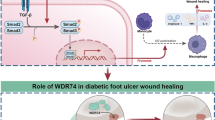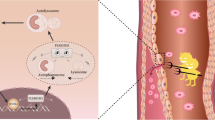Abstract
Our previous study had demonstrated that Runx1 promoted LPS-induced macrophage inflammatory response, however, the role of Runx1 in M2 macrophage polarization still remains largely unknown. This study was conducted to investigate the role of Runx1 in IL-4/IL-13-induced M2 macrophage polarization and its potential regulatory mechanism. We found that exposure of macrophages to IL-4/IL-13 induced a remarkable increasement in Runx1 expression level. Specifically, we established genetically modified mice lacking Runx1 in myeloid cells, including macrophages. RNA-Seq was performed to identify differentially expressed genes (DEGs) between Runx1 knockout and WT control bone marrow-derived macrophages (BMDMs). We identified 686 DEGs, including many genes which were highly expressed in M2 macrophage. In addition, bioinformatics analysis indicated that these DEGs were significantly enriched in extracellular matrix-related processes. Moreover, RT-qPCR analysis showed that there was an obvious upregulation in the relative expression levels of M2 marker genes, including Arg1, Ym1, Fizz1, CD71, Mmp9, and Tgm2, in Runx1 knockout macrophages, as compared to WT controls. Consistently, similar results were obtained in the protein and enzymatic activity levels of Arg1. Finally, we found that the STAT6 phosphorylation level was significantly enhanced in Runx1 knockout macrophages, and the STAT6 inhibitor AS1517499 partly reduced the upregulated effect of Runx1 deficiency on the M2 macrophage polarization. Taken together, Runx1 deficiency facilitates IL-4/IL-13-induced M2 macrophage polarization through enhancing STAT6 phosphorylation.





Similar content being viewed by others
DATA AVAILABILITY
The data that produced from this study are available from the corresponding author upon reasonable request.
References
Kolliniati, O., E. Leronymaki, E. Vergadi, et al. 2022. Metabolic regulation of macrophage activation. Journal of Innate Immunity 14: 51–68.
Russell, D.G., L. Huang, and B.C. VanderVen. 2019. Immunometabolism at the interface between macrophages and pathogens. Nature Reviews Immunology 19: 291–304.
Mosser, D.M., K. Hamidzadeh, and R. Goncalves. 2021. Macrophages and the maintenance of homeostasis. Cellular & Molecular Immunology 18: 579–587.
Ganesh, G.V., and K.M. Ramkumar. 2020. Macrophage mediation in normal and diabetic wound healing responses. Infammation Research 69: 347–363.
Murray, P.J. 2017. Macrophage polarization. Annual Review of Physiology 79: 541–566.
Gordon, S., and F.O. Martinez. 2010. Alternative activation of macrophages: Mechanism and functions. Immunity 32: 593–604.
Lawrence, T., and G. Natoli. 2011. Transcriptional regulation of macrophage polarization: Enabling diversity with identity. Nature Reviews Immunology 11: 750–761.
Li, L., D.S. Ng, W.C. Mah, et al. 2015. A unique role for p53 in the regulation of M2 macrophage polarization. Cell Death & Differentiation 22: 1081–1093.
Zhou, X., W. Li, S. Wang, et al. 2019. YAP aggravates inflammatory bowel disease by regulating M1/M2 macrophage polarization and gut microbial homeostasis. Cell Reports 27: 1176–1189.
Sood, R., Y. Kamikubo, and P. Liu. 2017. Role of RUNX1 in hematological malignancies. Blood 129: 2070–2082.
de Bruijn, M., and E. Dzierzak. 2017. Runx transcription factors in the development and function of the definitive hematopoietic system. Blood 129: 2061–2069.
Ono, M., H. Yaguchi, N. Ohkura, et al. 2007. Foxp3 controls regulatory T-cell function by interacting with AML1/Runx1. Nature 446: 685–689.
Zhang, F., G. Meng, and W. Strober. 2008. Interactions among the transcription factors Runx1, RORγt and Foxp3 regulate the differentiation of interleukin17-producing T cells. Nature Immunology 9: 1297–1306.
Prokunina, L., C. Castillejo-Lopez, F. Oberg, et al. 2002. A regulatory polymorphism in PDCD1 is associated with susceptibility to systemic lupus erythematosus in humans. Nature Genetics 32: 666–669.
Tokuhiro, S., R. Yamada, X. Chang, et al. 2003. An intronic SNP in a RUNX1 binding site of SLC22A4, encoding an organic cation transporter, is associated with rheumatoid arthritis. Nature Genetics 35: 341–348.
Lin, T.C. 2022. RUNX1 and cancer. Biochimica et biophysica acta (BBA)-reviews on cancer 1877: 188715.
Zheng, L.L., L. Cai, X.Q. Zhang, et al. 2022. Dysregulated RUNX1 predicts poor prognosis by mediating epithelialmesenchymal transition in cervical cancer. Current Medical Science 42: 1285–1296.
Li, Q., Q. Lai, C. He, et al. 2019. RUNX1 promotes tumour metastasis by activating the Wnt/β-catenin signalling pathway and EMT in colorectal cancer. Journal of Experimental & Clinical Cancer Research 38: 334.
Hong, M., J. He, D. Li, et al. 2020. Runt-related transcription factor 1 promotes apoptosis and inhibits neuroblastoma progression in vitro and in vivo. Journal of Experimental & Clinical Cancer Research 39: 52.
Luo, M.C., S.Y. Zhou, D.Y. Feng, et al. 2016. Runt-related transcription factor 1 (RUNX1) Binds to p50 in macrophages and enhances TLR4-triggered inflammation and septic shock. Journal of Biological Chemistry 291: 22011–22020.
Ray, A., and B.N. Dittel. 2010. Isolation of mouse peritoneal cavity cells. Journal of Visualized Experiments 35: 1488.
Toda, G., T. Yamauchi, T. Kadowaki, et al. 2020. Preparation and culture of bone marrow-derived macrophages from mice for functional analysis. STAR Protocols 2: 100246.
Shannon, P., A. Markiel, O. Ozier, et al. 2003. Cytoscape: A software environment for integrated models of biomolecular interaction networks. Genome Research 13: 2498–2504.
Bader, G.D., and C.W. Hogue. 2003. An automated method for finding molecular complexes in large protein interaction networks. BMC Bioinformatics 4: 2.
Chin, C.H., S.H. Chen, H.H. Wu, et al. 2014. cytoHubba: Identifying hub objects and sub-networks from complex interactome. BMC Systems Biology 8 (Suppl 4): S11.
Zhang, C., W. Li, X. Lei, et al. 2021. Targeting lysophospholipid acid receptor 1 and ROCK kinases promotes antiviral innate immunity. Science Advances 7: eabb5933.
Jablonski, K.A., S.A. Amici, L.M. Webb, et al. 2015. Novel markers to delineate murine M1 and M2 macrophages. PLoS ONE 10: e0145342.
Makita, N., Y. Hizukuri, K. Yamashiro, et al. 2015. IL-10 enhances the phenotype of M2 macrophages induced by IL-4 and confers the ability to increase eosinophil migration. International Immunology 27: 131–141.
Divakaruni, A.S., W.Y. Hsieh, L. Minarrieta, et al. 2018. Etomoxir inhibits macrophage polarization by disrupting CoA homeostasis. Cell Metabolism 28: 490–503.
Luiz, J.P.M., J.E. Toller-Kawahisa, P.R. Viacava, et al. 2020. MEK5/ERK5 signaling mediates IL-4-induced M2 macrophage differentiation through regulation of c-Myc expression. Journal of Leukocyte Biology 108: 1215–1223.
Martinez, F.O., L. Helming, R. Milde, et al. 2013. Genetic programs expressed in resting and IL-4 alternatively activated mouse and human macrophages: Similarities and differences. Blood 121: e57–e69.
Satoh, T., O. Takeuchi, A. Vandenbon, et al. 2010. The Jmjd3-Irf4 axis regulates M2 macrophage polarization and host responses against helminth infection. Nature Immunology 11: 936–944.
Liao, X., N. Sharma, F. Kapadia, et al. 2011. Krüppel-like factor 4 regulates macrophage polarization. Journal of Clinical Investigation 121: 2736–2749.
Odegaard, J.I., R.R. Ricardo-Gonzalez, M.H. Goforth, et al. 2007. Macrophage-specific PPARγ controls alternative activation and improves insulin resistance. Nature 447: 1116–1120.
Ruffell, D., F. Mourkioti, A. Gambardella, et al. 2009. A CREB-C/EBPβ cascade induces M2 macrophage-specific gene expression and promotes muscle injury repair. Proceedings of the National Academy of Sciences of the United States of America 106: 17475–17480.
Pello, O.M., M. De Pizzol, M. Mirolo, et al. 2012. Role of c-MYC in alternative activation of human macrophages and tumor-associated macrophage biology. Blood 119: 411–421.
Krausgruber, T., K. Blazek, T. Smallie, et al. 2011. IRF5 promotes inflammatory macrophage polarization and TH1-TH17 responses. Nature Immunology 12: 231–238.
Nepal, S., C. Tiruppathi, Y. Tsukasaki, et al. 2019. STAT6 induces expression of Gas6 in macrophages to clear apoptotic neutrophils and resolve inflammation. Proceedings of the National Academy of Sciences of the United States of America 116: 16513–16518.
Chi, Y., Z. Huang, Q. Chen, et al. 2018. Loss of runx1 function results in B cell immunodeficiency but not T cell in adult zebrafish. Open Biology 8: 180043.
Blyth, K., N. Slater, L. Hanlon, et al. 2009. Runx1 promotes B-cell survival and lymphoma development. Blood Cells, Molecules, and Diseases 43: 12–19.
Zhou, T., M. Luo, W. Cai, et al. 2018. Runt-related transcription factor 1 (RUNX1) promotes TGF-β-induced renal tubular epithelial-to-mesenchymal transition (EMT) and renal fibrosis through the PI3K subunit p110δ. eBioMedicine 31: 217–225.
Wang, Q., T. Stacy, M. Binder, et al. 1996. Disruption of the Cbfa2 gene causes necrosis and hemorrhaging in the central nervous system and blocks definitive hematopoiesis. Proceedings of the National Academy of Sciences of the United States of America 93: 3444–3449.
Mollo, N., M. Aurilia, R. Scognamiglio, et al. 2022. Overexpression of the Hsa21 transcription factor RUNX1 modulates the extracellular matrix in trisomy 21 cells. Frontiers in Genetics 13: 824922.
Liu, Y., Y. Zhang, Z. Ren, et al. 2023. RUNX1 upregulation causes mitochondrial dysfunction via regulating the PI3K-Akt pathway in iPSC from patients with down syndrome. Molecules and Cells 46: 219–230.
Lin, W., X. Wan, A. Sun, et al. 2021. RUNX1/EGFR pathway contributes to STAT3 activation and tumor growth caused by hyperactivated mTORC1. Molecular Therapy: Oncolytics 23: 387–401.
Kawabata, H. 2019. Transferrin and transferrin receptors update. Free Radical Biology and Medicine 133: 46–54.
Augoff, K., A. Hryniewicz-Jankowska, R. Tabola, et al. 2022. MMP9: A tough target for targeted therapy for cancer. Cancers (Basel) 14: 1847.
Nelson, S.M., X. Lei, and K.S. Prabhu. 2011. Selenium levels affect the IL-4-induced expression of alternative activation markers in murine macrophages. Journal of Nutrition 141: 1754–1761.
Odegaard, J.I., R.R. Ricardo-Gonzalez, A. Red Eagle, et al. 2008. Alternative M2 activation of Kupffer cells by PPARδ ameliorates obesity-induced insulin resistance. Cell Metabolism 7: 496–507.
Zhang, Y., T. Zuo, A. McVicar, et al. 2022. Runx1 is a key regulator of articular cartilage homeostasis by orchestrating YAP, TGFβ, and Wnt signaling in articular cartilage formation and osteoarthritis. Bone Research 10: 63.
Luo, Y., Y. Zhang, G. Miao, et al. 2019. Runx1 regulates osteogenic differentiation of BMSCs by inhibiting adipogenesis through Wnt/β-catenin pathway. Archives of Oral Biology 97: 176–184.
Yan, J., Z. Zhang, J. Yang, et al. 2015. JAK3/STAT6 stimulates bone marrow-derived fibroblast activation in renal fibrosis. Journal of the American Society of Nephrology 26: 3060–3071.
ACKNOWLEDGEMENTS
We would like to express our special thanks to Dr. Hongyan Wang (Shanghai Institute of Biochemistry and Cell Biology) for her kind assistance to this study.
Funding
This research was supported by the National Natural Science Foundation of China (82000678), the Young Talent Development Plan of Changzhou Health Commission (CZQM2021014), the Changzhou High-Level Medical Talents Training Project (2022CZBJ077), the Foundation of Science and Technology Development of Nanjing Medical University (NMUB2019315), and the Special Fund Project for Laboratory Medicine Research of Jiangsu Medical Association (SYH-3201160–0065).
Author information
Authors and Affiliations
Contributions
S. Zhou and T. Zhao performed the experiments and prepared the manuscript; T. Feng, T. Zhou, and P. Zhang designed the study and revised the manuscript; S. Zhou, T. Zhao, and W. Zhang analyzed the data; X. Chen, X. Zou, Y. Yang, and Q. Wang helped with the experiments. All authors read and approved the final manuscript.
Corresponding authors
Ethics declarations
Ethics Approval
Animal procedures were performed strictly in accordance with the Guide for the Care and Use of Laboratory Animals and were approved by the Institutional Animal Care and Use Committee of Nanjing Medical University.
Consent to Participate
Not applicable.
Consent for Publication
Not applicable.
Conflict of Interest
The authors declare no competing interests.
Additional information
Publisher's Note
Springer Nature remains neutral with regard to jurisdictional claims in published maps and institutional affiliations.
Rights and permissions
Springer Nature or its licensor (e.g. a society or other partner) holds exclusive rights to this article under a publishing agreement with the author(s) or other rightsholder(s); author self-archiving of the accepted manuscript version of this article is solely governed by the terms of such publishing agreement and applicable law.
About this article
Cite this article
Zhou, S., Zhao, T., Chen, X. et al. Runx1 Deficiency Promotes M2 Macrophage Polarization Through Enhancing STAT6 Phosphorylation. Inflammation 46, 2241–2253 (2023). https://doi.org/10.1007/s10753-023-01874-7
Received:
Revised:
Accepted:
Published:
Issue Date:
DOI: https://doi.org/10.1007/s10753-023-01874-7




